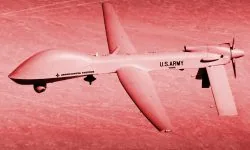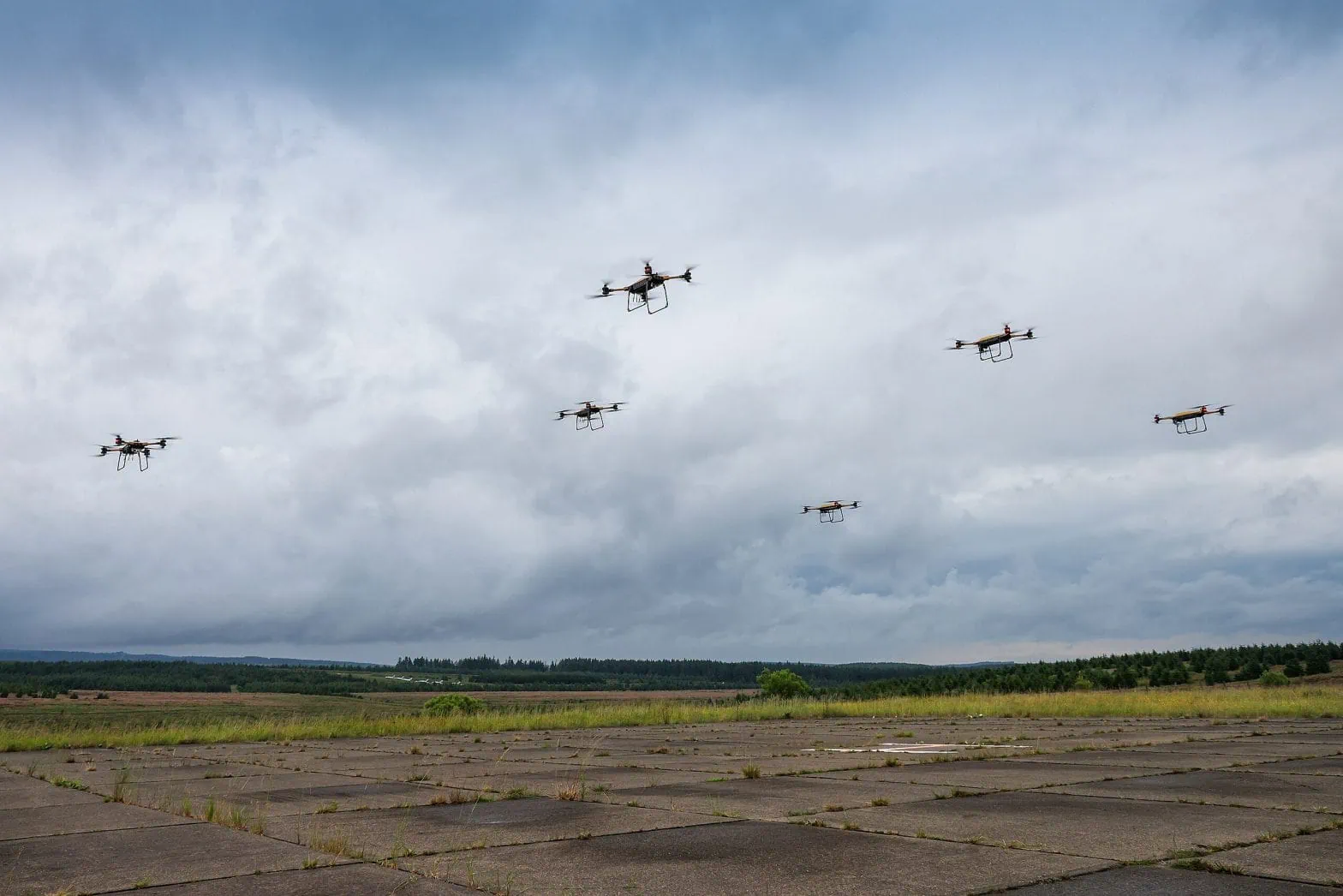(Image: UK MOD,
OGL v1.0OGL v1.0, via Wikimedia Commons )
AI is everywhere in the current Middle East wars.
In the Gaza war, triggered by the monstruous massacre inflicted by the Hamas militia on 7 October 2023, the Israel military is using machine learning in order to produce targets in Gaza ( “Octobre 7: How Hamas Attacked Israel, minute-by-minute”, Haaretz, 18 April, 2024, Daniel Byman, Riley McCabe, Alexander Palmer, Catrina Doxsee, Mackenzie Holtz, and Delaney Duff, « Hama’s October 7 Attack : Visualizing data“, CSIS, December 19, 2023, Connor Echols, “Israel using secret AI tech to target Palestinians”, Responsible Statecraft, April 23, 2024).
Artificial intelligence (AI) is also used to pilot the “Iron Dome” air defence system against Hezbollah and Houthis rockets and missiles (Gautam Ramachandra, “How artificial intelligence is improving “Iron Dome”“, May 13, Medium, 2023, and “Iron Dome is saving a lot of lives in Israel: here’s all about the world-famous air system”, The Economic Times, October 3, 224).
- Trump Geopolitics (2) – The US vs China Geoeconomic War

- AI at War (4): The US-China Drone and Robot Race

- How to use AI for Weak Signals – Trump, the International Revolutionary?

- 2d session of the Fifth Year of Advanced Training in Early Warning Systems & Indicators – ESFSI of Tunisia

- DeepSeek vs Stargate – China’s Offensive on U.S. AI Dominance?

- Trump Geopolitics – 1: Trump as the AI Power President

- Uranium for the U.S. Nuclear Renaissance – 2: Towards a global geopolitical race

- The New Space Race (1) – The BRICS and Space Mining

However, reciprocally Hamas, the Gaza Islamic militant militia, and its allies are using generative AI at strategic ends. It does so to flood social networks with edited and extremely moving pictures, films as well as fictitious images of the Palestinian civil casualties (David Klepper, “Fake Babies, real horror: Deepfakes from Gaza war increase fears about AI’s power to mislead”, AP, 28 November 2023).
Meanwhile, the conflicts between Israel, the Hezbollah militia and Iran involve electronic warfare, drones and hyper sonic missiles, which are all inherent to the “AI power” field (“When Artificial Intelligence will Power Geopolitics – Presenting AI”, The Red Team Analysis Society, November 27, 2017 and “Exploring cascading impacts with AI”, The Red Team Analysis Society, May 17, 2023 and “Portal to AI-Understanding AI and Foreseeing the AI powered world”, “Portal to Quantum Information Science and Technology- Towards a Quantum AI World ?” The Red Team Analysis Society .
In other words, the Middle East is a major area for the emerging AI warfare on conventional battlefields. It is also true in the cognitive and performative war dimensions and in the AI technology race. This begs the question of the consequences of these new technologies on the evolution of warfare.
Reciprocally, the question arises of knowing if the militarization of AI may become a driver of new risks of uncontrolled escalation?
Israel and AI warfare
AI on the battlefield(s)
AI is ubiquitous in the wars and battles that Israel wages in Gaza and in Lebanon, while activating its multilayer air defense systems constituted by the Iron Dome, David’s frond and the Arrow. Indeed, the Israeli offensive is a mix of conventional urban warfare and of an intense bombing campaign.
Military AIs, known as “Gospel”, “Lavender” and “Where’s Daddy ?”, are producing target lists (Connor Echols, “Israel using secret AI tech to target Palestinians”, Responsible Statecraft, April 23, 2024). The rhythm of this target’s production is extremely high and can reach a hundred targets a day. Human validation being extremely quick, the AI generation of targets imposes a constant rhythm of bombing (Yuval Abraham, ““Lavender”: the AI machine directing the bombing spree in Gaza”, 972, April 3, 2024).
Introducing
Read more…
With an additional focus on the shares of reserves and resources of actors. This powerful tool allows you to visualise and analyse geopolitical influence and company exposure to geopolitics in the uranium mining sector. Its companion report includes 12 use cases and their analysis.
In the case of the “Gospel”, a machine learning algorithm estimates the probability of the presence of a Hamas fighter or official in a house or a building at certain times of day. “Lavender” and “Where’s daddy” estimate probabilities regarding the schedule of the movements of a Hamas member, at work or with his family. However, the level of errors of those AIs is as high as 10% (Connor Echols, ibid).
So, the targeting process defines the rhythm of the bombing process. This military version of the “fourth industrial revolution” induces the conversion of numerous civilians into “collateral damages”. The risk is even greater if they are part of the 10% “margin error” (Noah Sylvia, “The Israel’s Defense Force use of AI in Gaza: a case of misplaced purpose”, Royal United Services Institute, 4 July 2024 and Yuval Abraham, ibid ).
Producing targets
The AI industrial rhythm of the targeting/bombing continuum is such that is among the most destroyed urban areas since the start of the 21st century (“How satellite radar helps scientists map destruction in Gaza” Market Place, 25 January 2024 and Daniele Palumbo, Abdelrahman Abutaleb, Paul Cusiac & Erwan Rivault, « At least half of Gaza’s buildings damaged or destroyed, new study shows », BBC, 30 January 2024, Evan Dyer).
In other terms, AI appears as being an unquestionable “force multiplier”, because it bestows upon Tsahal a twin capability of precise targeting, in such quantities that the series of targeted bombing acquire a “mass destruction” quality.
However, if, in the Israeli case, AI is a conventional “force multiplier”, it appears that very advanced military technology can still be mitigated. Older and conventional forms of battlefield preparations, such as tunnels and combat uses of urban landscape, are still quite efficient (Carlo J.V Caro, « Unpacking the history of Urban warfare and its challenges in Gaza », Stimson Centre, 17 October, 2023, John Keegan A History of Warfare, 1993, Edward Luttwak, Strategy, the Logic of War and Peace, Harvard University Press, 2002).
New technologies and the shock of the old
That is why after 11 months of high intensity war, the Hamas militia retains a military capability in Gaza: its fighters have been using the immense labyrinth of underground tunnels as a disruptive battlefield. Those narrow structures are forcing Israeli’s units to loose their cohesion and their firepower.
Also, their location protects them from a large proportion of the daily bombings (Nathan Rennolds, “It’s a trap, warns UK warns UK spy chief, as Israel prepares for months of brutal urban warfare against Hamas in bombed-out Gaza”, Business Insider, 15 October 2023).
Limits to AI military dominance growth
As it happens, those bombings are also a driver of the “paradoxical logic of strategy”, that, for example, has the capability to turn the race towards victory into failure (Edward Luttwak, Strategy, the Logic of War and Peace, Harvard University Press, 2002). Indeed, the pointillistic mass destruction of the Gaza urban landscape transforms the city into an impassable maze (Jean-Michel Valantin, “The war in Gaza and China’s pivot to the Middle East”, The Red Team Analysis Society, November 22, 2023)..
Deploying ground units in such an environment necessitates to disrupt their cohesion into small units. Those become de facto more vulnerable to a constant guerrilla warfare, which is in favour of the defendant, i.e the Hamas militia (David Kilcullen, The Dragon and the Snakes, How the Rest learned to fight the West, Hurst, 2020 and Stephen Biddle, Nonstate Warfare, the military methods of guerrillas, warlords, and militias, Princeton, Princeton University Press, 2021).
Thus, it appears that the AI generated bombing rhythm and scale has unintended military consequences. Indeed, as seen in each and every urban theatre of operations, they reinforce the level of difficulty inherent to the military penetration of an urban landscape ( David Kilcullen, Out of the Mountains, The coming age of urban guerrilla, Hurst and Company, 2015).
Thus, the destroyed urban landscape becomes a driver, among others, of the lengthening of the war. This time factor plays in favour of the Hamas, especially through the AI-based strategy of performative and cognitive warfare of the Islamic militant group.
AI Warfare and the diffusion of (Hamas) AI technostrategies
If AI allows the Israeli military to benefit from a force multiplier on the physical battlefield, generative AI opens up the cyberspace to performative and cognitive warfare.
Performative/cognitive warfare
Indeed, since November 2023, there is a flood of edited videos surging on social medias depicting the terrible sufferings of the civilian population of Gaza. Those contents are duplicated from one platform to the other. It is the case, for example from the Chinese TikTok to the U.S. X/Twitter (Jean-Michel Valantin, “The war in Gaza and China’s pivot to the Middle East”, The Red Team Analysis Society, November 22, 2023 and Matthew Ford and Andrew Hoskins, Radical War, Data, Attention and Control in the 21st Century, Hurst Publishing, 2022).
As it happens, the bombings in Gaza also shock and mobilize Arab opinions as well as many people staggered by the dreary conditions of the civil population of Gaza. Specifically in the Palestinian case, those collective emotions mingle with the painful problem of the Palestinian issue, still “unresolved” after almost 75 years of conflict (Avi Shlaim, The Iron Wall, Israel and the Arab World, Penguin Books, 2014).
Mobilization as brain targetting
Those video streams feed collective reactions, such as the massive pro-Palestinian protests throughout Europe and the Middle East. All these reactions are interacting with the Hamas videos and expand its reach and its scale of hyper object. As a result, throughout 2023 and 2024, the more the Israeli bombing and attacks have created victims, the more they have reinforced the anti-Israeli protests (“Global protests in support of Palestinians, rallies for hostages trapped in Gaza”, Reuters, October 22, 2023).
The full use of the interactive power of the social media matrix at the global, national and personal levels of the Hamas-Israel war becomes a mammoth driver of political emotions at the global scale (Lawrence Freedman, The Future of War: a History, Penguin Books, 2017, and David Kilcullen, The Dragons and the Snakes, How the Rest Learned to fight the West, Hurst, 2020).
This strategy then is prolonged by the flow of images, commentaries and interpretation of these online video streams at a global scale. Indeed, those video streams hybrid themselves with the explosive content of the political and affective collective memories of the Palestinian history “versus” the Israeli and Jewish history.
The information war strategy of the Hamas triggers an enormous and emotionally turbo-charged “conflict of interpretation” for these video streams, that infuses and immerses through constant dialectics the different levels of the political and military decision-making processes (Man, the State, and War: A Theoretical Analysis by Kenneth N. Waltz, New York, Columbia University: 1959).
Thus, in itself, this performative/political efficiency infuses the public opinions all around the world with the images of the Gaza war. Those images trigger very painful emotions in the population.
Generative AI and cognitive battlefield
In order to reinforce the impact of their performative strategy, the Hamas and its allies use generative AI. This innovative technology allows to produce fake pictures and victims, which are streamlined in the real videos. This editing approach is an « emotional force multiplier » (David Klepper, “Fake Babies, real horror: Deepfakes from Gaza war increase fears about AI’s power to mislead”, AP, 28 November 2023).
This strategy is tantamount to a cognitive warfare strategy. Indeed, the global diffusion of these videos on social medias is turning them into cognitive and emotional ammunitions. Furthermore, through the use of individual smartphones, those cognitive ammunitions impact millions of individual brains and psyches (Annamaria Sabû, Gabrielas Anca, “Using artificial intelligence tools for obtaining cognitive warfare advantage”, The Defence Horizon Journal, October 2023, 2023).
Those « cognitive strikes » are all the more powerful because of the AI produced reinforcement algorithms inherent to social networks. Those algorithms monitor the behaviour and preferences of each user. Through this knowledge, the algorithms multiply contacts between each user and videos with an high index of « popularity » (Cathy O’Neill, Weapons of Math Destruction, How Big data increases inequality and threatens democracy, Penguin Books, 2017 and Paul Scharre, Four Battlegrounds, Power in the age of artificial intelligence, W.W. Norton & Company, 2023).
Thus, the very logic of social networks becomes a « cognitive force multiplier » that turns Hamas into a « performative and cognitive warfare great power ». With such tools, Hamas is now waging a cognitive war against Israel. This strategy is a new way to wage « political warfare » through the influence that digital and AI tools confer to its users.
Technology, violence and war
The consequences of the very rapid integration of these new technologies to the management of war need to be understood very quickly. Indeed, since the 19th century, the nexus of science/industry/military/war leads to large-scale transformations in the levels and scale of violence and intensity of war.
For example, in the 17th century, almost 10 million Europeans were killed during the 30 Years’ war. 9 millions were killed during the 1914-1918 First World War (Geoffrey Parker, The Military revolution: Military innovation and the rise of the west, 1500-1800, Cambridge University Press, 1996).
This discrepancy is inherent in the unforeseen interactions between mass armies and industrial destructive capabilities. This logic was magnified and pushed to the extreme during the Second World War, ending in the use of the very first nuclear bombings on Hiroshima and Nagasaki (Niall Ferguson, The Pity of War, Explaining World War I, Basic Books, 2000 and The War of the World, History’s Age of Hatred, Allen Lane, 2006).
These examples reveal the way new technologies may inject new levels of violence in war. Thus, they trigger accelerated rates of escalation, while inflicting very high levels of damages and mass destruction.
Nowadays, the military uses of AI seem to trigger the very same logic. This logic manifests through the rising conflict between Israel, the Lebanese Hezbollah militia and Iran.
AI and escalation: Hezbollah
While the Gaza war was dragged on from 2023 to 2024, the Lebanese Hezbollah militia started shifting from missiles and rockets to drones in its attacks on Israel.
Hezbollah and the AI arms race
Since June 2024, Hezbollah has launched hundreds of drone attack upon the Israeli territory. Hezbollah uses Ababil-B acts as a loitering munition. It is able to change trajectories, making it very difficult for the Israeli multi-layered air defence system of the Iron Dome and David’s sling to intercept them (Ari Cicurel, Yoni Tobin, “Hezbollah’s new drone threat to Israel”, The Jewish Institute for National Security of America / JINSA, July 2, 2024, Bassem Mroue, “The threat Israel didn’t foresee: Hezbollah’s drone power”, AP, August 9, 2024).
Hezbollah also uses the Iran-made Shaheed drones. Those are equipped with GPS and manoeuvrable capabilities. They embark missiles and launch them while already flying over Israel. Thus, the Israeli air force and air defence systems have to disrupt both drones and missiles (Cicurel and Tobin, ibid).
This doubling of Hezbollah’s capability to penetrate the Israeli’s air protection through the association of drones and missiles leads to a greater number of strikes. These new weapons also indicate that the Shiite militia enters in the age of AI war technologies. Thus, it is entering into an arms race with Israel.
It also mobilizes the Israeli AI-piloted air defence system, as well as fighter planes and the fleet of combat helicopters. This situation induces massive costs. For example, during the 13 to 14 April 2024 night, Iran, the Hezbollah’s patron state, launched a mammoth 300 missiles and drones strike against the Hebrew state.
The large majority of these weapons was intercepted by the Israeli’s air defence as well as by U.S., UK, French and Jordanian air forces (Emmanuel Fabian, “IDF: 99% Of the 300 or so projectiles fired by Iran overnight were intercepted”, The Times of Israel, 14 April, 2024).
The economics of the Iron Dome
Meanwhile, the Israeli counter strikes cost more than 1 billion dollars to Jerusalem.
In other words, a full and repetitive use of the air defense systems is a way to harm financially the technologically dominant Israeli system. As it happens, the Houthis develop an analogous strategy in the Red Sea when they attack the U.S., UK, French and Israeli navies (Jean-Michel Valantin, “Apocalypse in the Red Sea- Anthropocene wars 9”, The Red Team Analysis Society, 20 February, 2024).
Networks of pagers, swarms of bombs
Facing this new Hezbollah’s techno-strategic threat, the Israeli military escalates in another domain. This happens through the ultra-precise targeting of the Hezbollah’s command structure. This leads to a series of impressively targeted strikes. The more notable are the simultaneous detonations of the 2100 pagers of the militia’s commanders, maiming or killing their holders (Jonathan Saul, Steven Scheer and Ari Rabinovitch, “Hezbollah’s pager attack puts spotlight on cyber warfare unit 8200”, Reuters, September 20, 2024).
Then, on 27 September 24, the Israeli air force launched several “bunker buster” bombs on Lebanon. Those weapons were piloted by JDAM / “smart bomb” devices. The attack killed Hassan Nasrallah, the political leader of Hezbollah in his underground headquarters in Beirut (Emmanuel Fabian, “Israel confirms bunker-buster bombs used in attack on Nasrallah”, The Times of Israel, 29 September 2024).
The JDAM system (“Joint direct attack munition”) is a guidance system that combines inertial guidance and Global Positioning System and that is compatible with multiple bombing systems (“Joint Direct Attack Munitions”, Military.com). This system turns the bomb into an autonomous inertial weapon system. It can correct its own trajectory with a 5 meters accuracy.
The last generation of JDAM systems integrate AI reinforcement. In 2023, experiments with this innovative evolution of JDAM were aiming at making the bombs work together as a swarm, dubbed “the Golden Horde” (Joseph Trevithic, “Jet-powered JDAM aims to turn bombs into cruise missiles”, The War Zone, 24 October, 2023).
Hypersonic missiles in the Sky
On 30 September, in retaliation to this strike, Iran, the patron state of Lebanese Hezbollah, launched a 180 missiles strong salvo against Israel. This is the second missile strike against Israel since April 2024.
It could appear as a “classical” form of strategic demonstration. On the one hand, it allows the Iranian theocracy not to lose face. On the other hand, the Israeli defense system AIs were able to intercept more than 300 projectiles at the same time. (Gautam Ramachandra, “How artificial intelligence is improving “Iron Dome”, May 13, Medium, 2023, and “Iron Dome is saving a lot of lives in Israel: here’s all about the world-famous air system”, The Economic Times, October 3, 224).
However, this new Iranian strike includes several “Fattah” hypersonic missiles. Those ballistic missiles integrate AI systems in order to be able to self-correct their Mach 13-Mach 15 trajectory. It appears that some of these missiles breached the multi-layered Israeli defences (Devika Bhattacharya, “October 2, 2024 and “ Fattah 2: How Iran used hypersonic missile to pierce Israel’s air defence”, India Today, “How Iran Fattah and Gahdr missiles defeated Israel’s advanced air systems”, The Economic Times, October 3, 2024).
As it happens, this Iranian strike raises a strategic issue: if the Islamic Republic succeeds in achieving its nuclear program, there are reasons to believe that the hybridation of nuclear bombs and hypersonic missiles will not be far away. What will happen then to the regional and international balance of power? So, this technological and strategic race may also become, if it is not already the case, a driver of strategic escalation across the Middle East.
Who will dominate dominant technologies ?
In other terms, the militarization of AI confers a relative advantage to the Israeli military. However, this technological and military wave spreads rapidly across the Middle East. Israel is a world leader in terms of AI development as well as in innovative weaponry. However, the extension of warfare and of theatres of operations in the AI field is driving changes in warfare. Among those, the emergence of cognitive warfare as well as of new generations of offensive weapons have great impact.
This new technological wave drives the development of new forms of strategies playing alternatively or simultaneously in different domains. The military AI wave is starting to have a conventional as well as performative and cognitive “force multiplier” effect in a region already saturated with strategic tensions and conflicts.
It remains to be seen how this technological / strategic evolution is going to impact the rising conflicts, and if governments are going to be able to contain the new forces they unleashed into old conflicts.
Or not.
In which case, technology-driven escalation in the Middle East is going to have to be assessed.



A vous lire, on croirait que toutes les atrocites commises par Tsahal et ces dizaines de milliers de victimes, dont une majorite d’enfants ne sont qu’un pur produit de l’IA. Dommage!
Ce n’est certainement pas ce qui est écrit dans l’article.